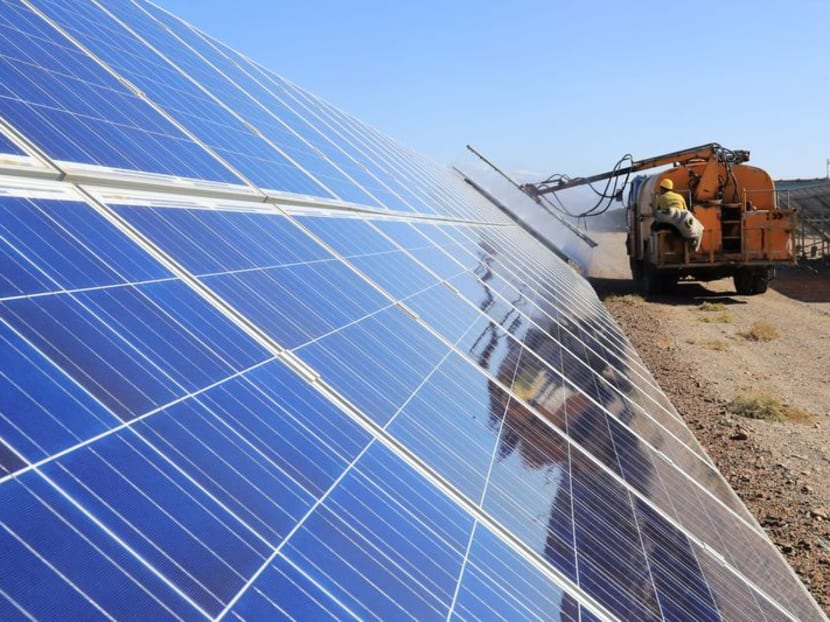CNA Parkway Story 1

FILE PHOTO: A worker operates a machinery to clean solar panels at a photovoltaic industrial park in Hami, Xinjiang Uighur Autonomous Region, China October 22, 2018. Picture taken October 22, 2018. REUTERS/Stringer

Why risk-reducing mastectomy can be self-empowering for some women
Removing one or both breasts without a cancer diagnosis may sound drastic. But for patients with a genetic mutation linked to breast cancer, the surgery reduces their cancer risk by up to 90 per cent.

ngelina Jolie and Sharon Osbourne share something in common. And it’s not their celebrity status. These female stars have undergone what’s commonly known as a preventive or prophylactic mastectomy, which means the surgical removal of one or both breasts. They have an inherited mutation of the BRCA1 or BRCA2 gene that significantly increases their risk of developing breast cancer.
In 2013, Jolie wrote an opinion piece in The New York Times , sharing how her mother passed away from breast cancer at 56. As she had a BRCA1 gene mutation, doctors estimated that she would have an 87 per cent chance of getting breast cancer.
For a public figure known for her enviable physique, Jolie admitted that deciding to have a preventive mastectomy – when she hadn’t been diagnosed with breast cancer yet – was difficult. But it was also a “happy” decision as her chances of developing breast cancer post- surgery fell from 87 per cent to under 5 per cent. Just as empowering for the mother of six was how she could tell her then-young brood that they won’t be losing her to breast cancer

Considering a family history of cancer
In Singapore, a preventive mastectomy can be a self-empowering decision for patients, said Dr Tan Yah Yuen, senior consultant and breast surgeon at Solis Breast Care & Surgery Centre, adding that the preferred medical term is a “risk-reducing mastectomy”.
Either way, this surgical procedure frees them from the psychological fear of developing breast cancer. “It is a proactive decision on the woman’s part to reduce her lifetime risk of breast cancer,” she said. “The women willing to consider this step are usually not apprehensive, angry or sad. They are logical, decisive and objective, and the desire to be in control of their fate outweighs their anxiety about the surgery.”
These patients are in their mid-30s to 50s with a significantly elevated risk of breast cancer. They may include women with biopsy-proven breast abnormalities and those with a BRCA1 or BRCA2 gene mutation.


Up to
0
%
The lifetime risk of breast cancer for women with a BRCA1 or BRCA2 gene mutation. A mastectomy reduces this by up to 90 per cent.
Early, regular screening can mean a higher chance of a cure
So, how would you know or even suspect you have a BRCA1 or BRCA2 gene mutation?
Dr Wong Chiung Ing, senior consultant and medical oncologist at Parkway Cancer Centre, explained: “BRCA1 or BRCA2 is an inherited mutation. If many close family members are diagnosed with cancer at an early age, one should be vigilant and be aware that an inherited genetic mutation from generation to generation may be the cause of the family member’s cancer. In such a situation, an individual may also have inherited the same mutation, which increases the risk of cancers.”
If you suspect this, you will need to be counselled before deciding if the BRCA1 and BRCA2 mutation test is indicated. Dr Wong explained that anyone with a mutation should start cancer screening earlier and consider risk-reducing surgery as their cancers tend to be more aggressive and are diagnosed at a younger age.
It is important to note that genetic mutation is one of the many risk factors for breast cancer. Other risk factors include the early onset of menstruation, late menopause, drinking too much alcohol and being overweight. Even if you have none of these risk factors, it is still possible to develop breast cancer
Dr Wong advises all women to do regular breast cancer screening, including monthly breast self-examination from the age of 20 and annual mammograms from age 40. She said: “If breast cancer is diagnosed early when it is small and confined to the breast, the cure rate is as high as 99 per cent. The earlier the stage of detection, the higher the chance of cure.”















